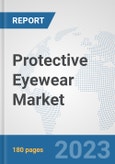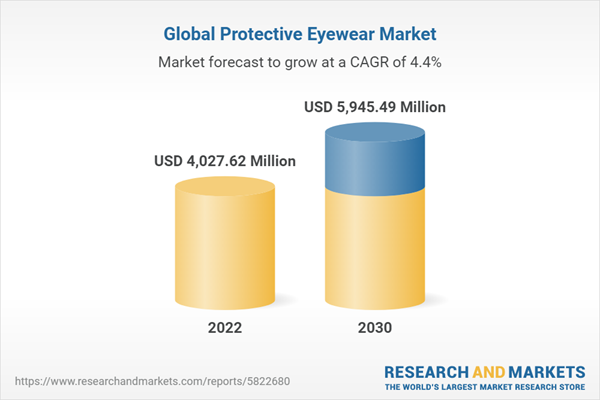The primary purpose of protective eyewear is to provide a secure and enclosed fit around the eyes, eye sockets, and surrounding facial area, effectively safeguarding the wearer from potential harm. It offers reliable protection against impacts, dust, mists, vapors, and splashes. The protective eyewear is designed with various coatings such as anti-scratch and anti-fog options, making it suitable for regular use as well as industries like oil and gas, construction, and mining.
Protective eyewear is available in different types, including goggles, direct ventilated products, indirect ventilated products, and non-ventilated products, and they come in a wide range of sizes and styles. The selection of appropriate protective eyewear depends on factors such as size, type of safety blockers, comfort, and budget. The growing emphasis on workplace regulations and the increasing occurrence of eye injuries are driving significant growth in the protective eyewear market.
Goggles to dominate the Type segment of the Protective Eyewear Market
Protective eyewear, such as goggles, is specifically designed to minimize the potential harm to the eyes by offering full coverage and a secure fit. Goggles are commonly used in specialized industries and environments where there is a high risk of splashes, sprays, or chemical exposure. With their comprehensive design that covers the sides, top, and bottom of the eyes, goggles provide a higher level of protection compared to other protective eyewear. This design effectively prevents particles, chemicals, or liquids from entering the eyes from any direction, offering superior defense against chemical splashes and liquid hazards.The snug fit and seal around the eyes create a barrier against airborne hazards, reducing the chances of particles or liquids entering the eye area. Additionally, certain goggles feature ventilation systems or anti-fog coatings, ensuring clear vision and minimizing fogging issues, even during prolonged use. Overall, protective eyewear, particularly goggles, is crucial for minimizing the risk of eye injuries and providing optimal eye protection in various specialized industries and environments.
North America to be the dominant region in the Protective Eyewear Market
The protective eyewear market in North America has witnessed significant growth, primarily due to the increasing focus on worker safety awareness in the region. Stringent safety regulations and standards established by regulatory bodies such as the Occupational Safety and Health Administration (OSHA) in the United States and the Canadian Centre for Occupational Health and Safety (CCOHS) in Canada play a crucial role in driving this growth. Employers are obligated to provide and enforce the usage of appropriate protective eyewear in workplaces where there are potential eye hazards, which further contributes to the demand for these products. Additionally, the healthcare sector in North America relies on protective eyewear for medical professionals, including doctors, nurses, and technicians. These professionals wear goggles or safety glasses to safeguard their eyes from exposure to bloodborne pathogens, chemicals, infectious diseases, and other potential hazards in healthcare settings.Report Findings
1) Drivers
- Growing awareness about personal protective equipment and the importance of workplace safety has led to an increased demand for protective eyewear.
- Stringent safety regulations and standards implemented by governments and regulatory bodies across various. Industries drive the demand for protective eyewear
2) Restraints
- The lack of mandatory regulations and inadequate emphasis on employee safety in certain regions are significant restraints for the global prescription safety glasses market throughout the forecast period
3) Opportunities
- The expansion of industries, including manufacturing, construction, oil and gas, and mining, can create a higher demand for protective eyewear.
Research Methodology
A) Primary Research
The primary research involves extensive interviews and analysis of the opinions provided by the primary respondents. The primary research starts with identifying and approaching the primary respondents, the primary respondents are approached include- 1. Key Opinion Leaders associated with the publisher
- 2. Internal and External subject matter experts
- 3. Professionals and participants from the industry
The primary research respondents typically include
- 1. Executives working with leading companies in the market under review
- 2. Product/brand/marketing managers
- 3. CXO level executives
- 4. Regional/zonal/country managers
- 5. Vice President level executives
B) Secondary Research
Secondary research involves extensive exploring through the secondary sources of information available in both the public domain and paid sources. Each research study is based on over 500 hours of secondary research accompanied by primary research. The information obtained through the secondary sources is validated through the crosscheck on various data sources.The secondary sources of the data typically include
- 1. Company reports and publications
- 2. Government/institutional publications
- 3. Trade and associations journals
- 4. Databases such as WTO, OECD, World Bank, and among others.
- 5. Websites and publications by research agencies
Segments Covered
The global protective eyewear market is segmented on the basis of type, and end user industry.The Global Protective Eyewear Market by Type
- Spectacles
- Overspecs
- Welding Protection Glasses
- Goggles
The Global Protective Eyewear Market by End User Industry
- Automotive
- Food Industry
- Construction
- Oil and Gas
- Pharmaceutical
- Mining
- Other End User Industries
Company Profiles
The companies covered in the report include
- 3M
- Bollé Safety
- Radians, Inc.
- Honeywell International
- MCR Safety
- Pyramex
- Phillips Safety Products Inc.
- uvex group
- Gateway Safety, Inc.
- SSP Eyewear
What does this Report Deliver?
1. Comprehensive analysis of the global as well as regional markets of the protective eyewear market.2. Complete coverage of all the segments in the protective eyewear market to analyze the trends, developments in the global market and forecast of market size up to 2030.
3. Comprehensive analysis of the companies operating in the global protective eyewear market. The company profile includes analysis of product portfolio, revenue, SWOT analysis and latest developments of the company.
4. Growth Matrix presents an analysis of the product segments and geographies that market players should focus to invest, consolidate, expand and/or diversify.
Table of Contents
Companies Mentioned
- 3M
- Bollé Safety
- Radians, Inc.
- Honeywell International
- MCR Safety
- Pyramex
- Phillips Safety Products Inc.
- uvex group
- Gateway Safety, Inc.
- SSP Eyewear
Table Information
| Report Attribute | Details |
|---|---|
| No. of Pages | 180 |
| Published | May 2023 |
| Forecast Period | 2022 - 2030 |
| Estimated Market Value ( USD | $ 4027.62 Million |
| Forecasted Market Value ( USD | $ 5945.49 Million |
| Compound Annual Growth Rate | 4.4% |
| Regions Covered | Global |
| No. of Companies Mentioned | 10 |









